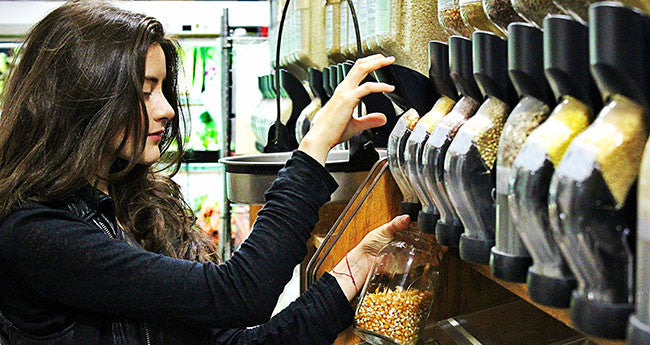15 Bulletproof Steps to Shop with Zero Waste

“Zero waste” shopping is not as difficult as some people might assume; it simply involves adjusting some of your daily habits. It is no different than any other lifestyle changes, be it exercising, eating healthy or being more productive with your time. With appropriate planning and organization, you can reduce your mark on the landfills significantly. Here are 15 effective steps to get you into the “zero waste” shopping lifestyle. You will notice that the effects of the anti-waste lifestyle go beyond ‘just’ saving the environment — they lead to huge changes in your well being as well.
Plan ahead
Do not rush into shopping. Make grocery lists and think ahead about the things you actually need for you and your family. Becoming conscious of what you buy significantly reduces the urge for impulsive shopping, and brings more awareness to the excesses in your life. Also, if your shopping activities are well thought through, you will spend less time going to the supermarkets.
Buy bulk without packaging
Aside from not leaving any garbage that way, you will turn your attention away from unhealthy packaged food to healthy natural food — organic fruits and vegetables, grains, and a wide variety of local foods from the farmer’s market are only some of the unpackaged delicious choices offered in your local supermarket.
Bring your own packaging
Glass jars, reusable water bottles, cotton bags, totes — the possibilities are limitless! If something needs to be weighed, the store employee can easily measure the weight of your jar first.
Always keep spare bags with you
Always keep a few jars or tote bags in the back of your car. That way, even if an unplanned purchase happens, and it sometimes will, you will be prepared.
Use the free app BULK to find reusable container-friendly stores
Sometimes you might run into difficulties with stores that do not allow you to use your own storage containers. It’s not ‘hygienic enough’, is often a reason they bring up. The free app BULK solves this problem and it works across the US and Canada. You can limit your search by locations closest to your address, or by item type – whether it is dog food, wine, dairies or something else.
Choose the lesser evil
If you really have to use the packaging in the supermarket, go for reusables- paper, metal, or glass. Avoid the plastic. Even though you might feel okay because you know you will recycle it, remember that plastic never gets completely recycled. It is only degraded into a less detrimental form.
Give experiences as presents, not things
Revisit the idea of presents; instead of buying a dress for your daughter, give her an experience — take her to the amusement park, a children’s show, or a picnic!
Let DIY become your family’s new hobby
Instead of buying, make your own wallets, jewelries and decorative items from plastic, paper, and other leftovers you have. YouTube is full of how-to-dos! Developing new skills is just a plus.
Make your own cosmetics
Instead of buying chemical-based cosmetics (let’s face it, most of them are), and leaving piles of plastic packaging to be “recycled”, start buying fresh raw ingredients and making your own toothpastes, creams, and scrubs. That way you choose the substances that you want in and on your body and really know what is in the products you use. It is not too difficult and many DIY websites have info on how to do this. Plus, you get to be creative and experiment – and if you include your children, it can be a fun Sunday activity for the whole family.
Reinvent leftovers
You made rice with vegetables for lunch 2 days ago and nobody in the family seems particularly interested in finishing it? Rather than throwing it out, just add some tomato sauce or curry into the leftover, warm it up and serve up the new flavors. You can get very creative with this.
Say no to receipts, straws, and plastic bags
Again, be prepared to think ahead. Many of these actions are automatic for the waiter/sales clerk. Anticipate them and prevent it before they happen. After a while, the girl from the local supermarket will remember you (that’s the one who doesn’t want bags), and will stop offering the plastic bag to you. With your example, you might even inspire someone else in the line!
Keep away from the Styrofoam
According to the book Garbology by the Pulitzer-prize winning author Edward Humes, 19 billion pounds of polystyrene peanuts (Styrofoam) are dumped in the US on a yearly basis, since it is impossible to recycle. Avoid buying products with this.
Use old clothes to make new ones
You are probably well aware of the piles of old clothes in your closet. Do you really need to buy more? Get creative and use the things you already have as raw materials – dye the old oversized T-shirt, tie the sleeves into a bow, and make a new dress of it! If you are unsure how to do this, loads of DIY websites have great tutorials. You can also get your local tailor to help you out.
The hidden gems in second hand shops
Second hand shopping is an adventure; you never know what you will find 
Start “zero waste” practice as an experiment
To get yourself into the “zero waste” state of mind, try it out for 5-10 days as an experiment first. Also, start with small adjustments and then expand — it will be easier to implement gradual change in your shopping routine.
What’s Next?
Do you have any tips for “zero waste” shopping? Let us know in the comments.
Also, share this article with your friends and help them go “zero waste” as well! Just click the share buttons below.






